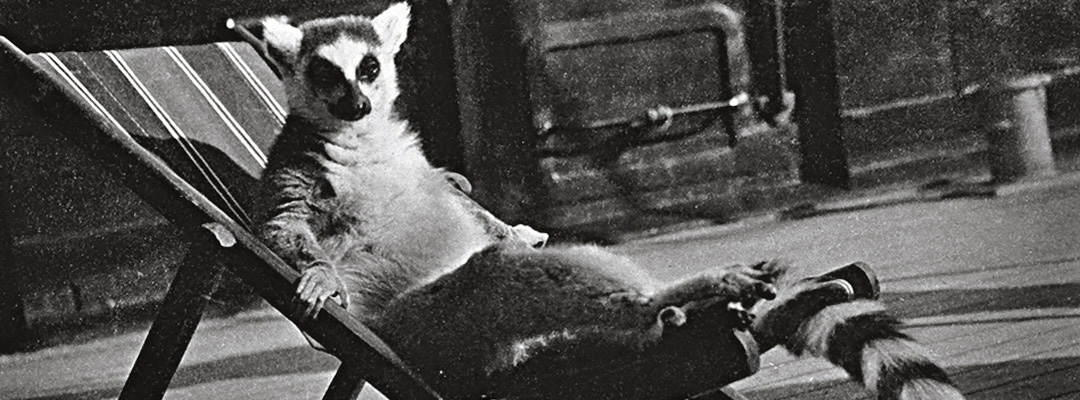Mah-Jongg, the Eltham Palace Lemur
How Stephen and Virginia Courtauld, owners of Eltham Palace in south London, lavished attention – and interior designers – on their much-indulged ring-tailed lemur in the 1930s.

THE MARCHIONESS AND THE MILLIONAIRE
Virginia Peirano and Stephen Courtauld met in the Alps. She was impulsive, creative and unconventional, with the title of marchioness from her first, unhappy marriage. Stephen, scion of the Courtauld textile empire and a keen mountaineer, was quiet and ‘unflappable’, according to a former colleague. He had received the Military Cross in 1918, fighting with the Artists’ Rifles.
They were married in 1923 in Fiume (now Rijeka, Croatia). They were both in their early forties, and childless.
PET NAMES
On their return to England, they bought a ring-tailed lemur from the Harrods pet department. They christened him Mah-Jongg, although he was soon affectionately known simply as ‘Jongy’.
Among the privileged Bright Young Things (or in the case of the Courtaulds, Middle-Aged Things) of the 1920s and 1930s, exotic or unusual pets were all the rage. Unity Mitford had a grass snake called Enid and took her pet rat to debutante balls. Evelyn Waugh, who satirised this fashionable set in novels including Vile Bodies, described another pet lemur as ‘half a cat and half a squirrel and half a monkey’.
CHARMED AND DANGEROUS
With a large disposable income, the Courtaulds were at the centre of interwar London society, and were noted patrons of the arts. They also loved sailing. With the help of his brother-in-law, Stephen designed a motor yacht he named the Virginia. Over the winter of 1936, the couple sailed her from Cape Town to Egypt; other voyages saw them collecting orchids and making films around the South China Sea.
Mah-Jongg, lounging in a specially designed deckchair, brought a certain tropical cachet to these trips. But he disgraced himself at a farewell lunch for the British Arctic Air Route Expedition on board the Virginia when he bit the expedition’s wireless operator, Percy Lemon, so viciously that he severed an artery. Lemon did not fully recover for three months.
ELTHAM REVISITED
Looking for a new home close to London, the Courtaulds bought the site of Eltham Palace in 1933.
There, the architects Seely and Paget designed a remarkable modern mansion for them incorporating Eltham’s medieval Great Hall. It was lavishly decorated in an eclectic range of styles, from the Art Deco of the dining room to the Swedish-designed entrance hall.
RING-TAILED MUSE
Stephen and Virginia made sure that these glamorous designs didn’t exclude Mah-Jongg: his image was incorporated into Eltham’s architectural and decorative fabric. The mural in the billiard room by Mary Adshead, depicting St Cecilia, features a lemur sitting beside a column, and during the restoration of the Great Hall, new wooden bosses were carved in the likeness of a curled-up Mah-Jongg.
Jongy’s spacious living quarters were on the first floor at the centre of the new house, where its two wings met. From a trapdoor in the floor, a bamboo ladder led to the Flower Room, adjacent to the entrance hall.
His quarters were, like the rest of the house, centrally heated, providing a tropical climate. The cage’s décor of Madagascan rainforests, by Gertrude Whinfield, must have made Jongy feel quite at home. Exoticism of all kinds is reflected elsewhere in Eltham’s décor: the door reliefs in the dining room, for example, combine Classical Greek motifs with depictions of animals and birds from London Zoo.
Mah-Jongg died in 1938, after 15 years spent sharing the Courtaulds’ glamorous lifestyle. Although he only lived at Eltham for four years, his enduring influence on one of the most beautiful 1930s buildings in England can still be seen there today.
By Xanthe Dennis
Drawn from the English Heritage Red Guide to Eltham Palace by Michael Turner
More about Eltham Palace
-

History of Eltham Palace
Learn about the long history of this unique palace, from its medieval origins to the 20th century.
-

Description of Eltham Palace
The ultra-fashionable house designed for the Courtaulds in the 1930s incorporated the great hall of the medieval palace. Find out more.
-

Seely and Paget at Eltham Palace
Find out how John Seely and Paul Paget transformed medieval Eltham Palace into an art deco mansion for the Courtaulds in the 1930s.